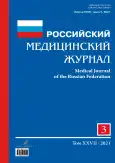Relationship of potential biomarkers of interstitial cystitis/painful bladder syndrome
- Authors: Sholan R.F.1
-
Affiliations:
- Republican Centre of Diagnosis and Treatment
- Issue: Vol 27, No 3 (2021)
- Pages: 257-264
- Section: Clinical medicine
- URL: https://journals.rcsi.science/0869-2106/article/view/55325
- DOI: https://doi.org/10.17816/0869-2106-2021-27-3-257-264
- ID: 55325
Cite item
Abstract
BACKGROUND: Biomarker identification fulfills the need for simple, accurate, and non-invasive diagnostic methods for interstitial cystitis/painful bladder syndrome (IC/PBS). The simultaneous study of cytokines and growth factors is essential for understanding the role of biomarkers.
AIM: This work determines the concentration of interleukins (IL) 6 and 8, nerve growth factor (NGF), heparin-binding epidermal growth factor (HB-EGF), and their relationship in patients with IC/PBS.
MATERIALS AND METHODS: This study examined 126 female patients with IC/PBS, with a mean age of 46.7±14.0 years. The disease duration averaged 6.0±2.8 years. The control group consisted of 20 women without IC/PBS, with a mean age of 35.3±9.7 years. The level of IL-6 and IL-8 in blood serum and urine was determined by ELISA. The NGF and HB-EGF levels were determined by ELISA using the appropriate test kits. Statistical analysis was performed using SPSS software version 15.0. The Student’s t-test and Spearman’s correlation coefficient were calculated.
RESULTS: In patients with IC/PBS, blood levels of IL-6 and IL-8 exceeded the control indicator by 65.99% (t=4.62, p=0.000) and by 67.14% (t=2.81, p=0.006), respectively, the NGF level exceeded it by 8.82% (t=0.10, p=0.920), and the HB-EGF level decreased by 30.84% (t=0.62, p=0.537). In urine, the level of IL-6 in IC/PBS was increased by 52.94% (t=7.62, p=0.000), IL-8 level was increased by 57.53% (t=2.01, p=0.049), NGF was increased by 50.44% (t=2.06, p=0.043), and HB-EGF level was increased by 56.44% (t=2.01, p=0.049). Cytokines correlated with growth factors with weakly bound in blood and urine (p >0.05). A strong, direct relationship was registered between the urine levels of NGF and HB-EGF (r=+0.987, p <0.05).
CONCLUSIONS: Correlations between IL-6 and IL-8 with NGF and HB-EGF in urine indicate an increased risk of damage to the bladder epithelium. The increase in urinary HB-EGF is a response to a significant increase in urinary NGF and may be a bladder epithelial defense mechanism.
Full Text
##article.viewOnOriginalSite##About the authors
Rashad F. Sholan
Republican Centre of Diagnosis and Treatment
Author for correspondence.
Email: ittihaf@yahoo.com
ORCID iD: 0000-0002-1047-167X
MD, Cand. Sci. (Med.)
Azerbaijan, BakuReferences
- Davis NF, Gnanappiragasam S, Thornhill JA. Interstitial cystitis/painful bladder syndrome: the influence of modern diagnostic criteria on epidemiology and on Internet search activity by the public. Transl Androl Urol. 2015;4(5):506–511. doi: 10.3978/j.issn.2223-4683.2015.06.08
- Patnaik SS, Lagana AS, Vitale SG, et al. Etiology, pathophysiology and biomarkers of interstitial cystitis/painful bladder syndrome. Arch Gynecol Obstet. 2017;295(6):1341–1359. doi: 10.1007/s00404-017-4364-2
- Kuz'min IV, Ignashov YA, Slesarevskaja MN, Al'-Shukri SK. Bladder pain syndrome in women: criteria for efficacy and predicting treatment outcomes. Experimental and Clinical Urology. 2020;2: 142–148. (In Russ). doi: 10.29188/2222-8543-2020-12-2-142-148
- Loran OB, Sinjakova LA, Mitrohin AA, et al. Modern view of the problem of interstitial cystitis. Medical advice. 2011;11-12:15–19. (In Russ).
- Onopko VF, Kirilenko EA, Baranova EO, Golubeva VS. Interstitial cystitis or bladder pain syndrome: a modern perspective on the problem. Acta Biomedica Scientifica (East Siberian Biomedical Journal). 2016;1(1):65–69. (In Russ). doi: 10.12737/21489
- Slesarevskaja MN, Ignashov YA, Kuz'min IV. Modern approaches to the diagnosis of painful bladder syndrome. Urological statements. 2017;7(2):25–30. (In Russ). doi: 10.17816/uroved7225-30.
- Zajcev AV, Sharov MN, Ibragimov RA, et al. Bladder pain syndrome/interstitial cystitis: modern view for diagnostic and treatment. Emergency doctor. 2018;8:16–26. (In Russ).
- Yoshimura N, Oguchi T, Yokoyama H, et al. Bladder afferent hyperexcitability in bladder pain syndrome/interstitial cystitis. Int J Urol. 2014;21(Suppl 1):18–25. doi: 10.1111/iju.12308
- Magalhaes TF, Baracat EC, Doumouchtsis SK, Haddad JM. Biomarkers in the diagnosis and symptom assessment of patients with bladder pain syndrome: a systematic review. Int Urogynecol J. 2019;30(11):1785–1794. doi: 10.1007/s00192-019-04075-9
- Liu HT, Kuo HC. Biomarkers for patients with interstitial cystitis/bladder pain syndrome. Urological Science. 2015;26(4):225–229. doi: 10.1016/j.urols.2015.02.002
- Kim SR, Moon YJ, Kim SK, Bai SW. NGF and HB-EGF: potential biomarkers that reflect the effects of fesoterodine in patients with overactive bladder syndrome. Yonsei Med J. 2015;56(1):204–211. doi: 10.3349/ymj.2015.56.1.204
- Kim SW, Im YJ, Choi HC, et al. Urinary nerve growth factor correlates with the severity of urgency and pain. Int Urogynecol J. 2014;25(11):1561–1567. doi: 10.1007/s00192-014-2424-8
- Kim J, Kim WT, Kim WJ. Advances in urinary biomarker discovery in urological research. Investig Clin Urol. 2020;61(Suppl 1):S8–S22. doi: 10.4111/icu.2020.61.S1.S8
- Gillenwater JY, Wein AJ. Summary of the National Institute of Arthritis, Diabetes, Digestive and Kidney Diseases Workshop on Interstitial Cystitis, National Institutes of Health, Bethesda, Maryland, August 28-29, 1987. J Urol. 1988;140(1):203–206. doi: 10.1016/s0022-5347(17)41529-1
- World Medical A. World Medical Association Declaration of Helsinki: ethical principles for medical research involving human subjects. JAMA. 2013;310(20):2191–2194. doi: 10.1001/jama.2013.281053
- Corcoran AT, Yoshimura N, Tyagi V, et al. Mapping the cytokine profile of painful bladder syndrome/interstitial cystitis in human bladder and urine specimens. World J Urol. 2013;31(1):241–246. doi: 10.1007/s00345-012-0852-y
- Tonyali S, Ates D, Akbiyik F, et al. Urine nerve growth factor (NGF) level, bladder nerve staining and symptom/problem scores in patients with interstitial cystitis. Adv Clin Exp Med. 2018;27(2):159–163. doi: 10.17219/acem/69231
- Don ES, Tarasov AV, Jepshtejn OI, Tarasov SA. Biomarkers in medicine: search, selection, study and validation. Clinical laboratory diagnostics. 2017;62(1):52–59. (In Russ). doi: 10.18821/0869-2084-2017-62-1-52-59
- Liu HT, Kuo HC. Increased urine and serum nerve growth factor levels in interstitial cystitis suggest chronic inflammation is involved in the pathogenesis of disease. PLoS One. 2012;7(9):e44687. doi: 10.1371/journal.pone.0044687
Supplementary files









